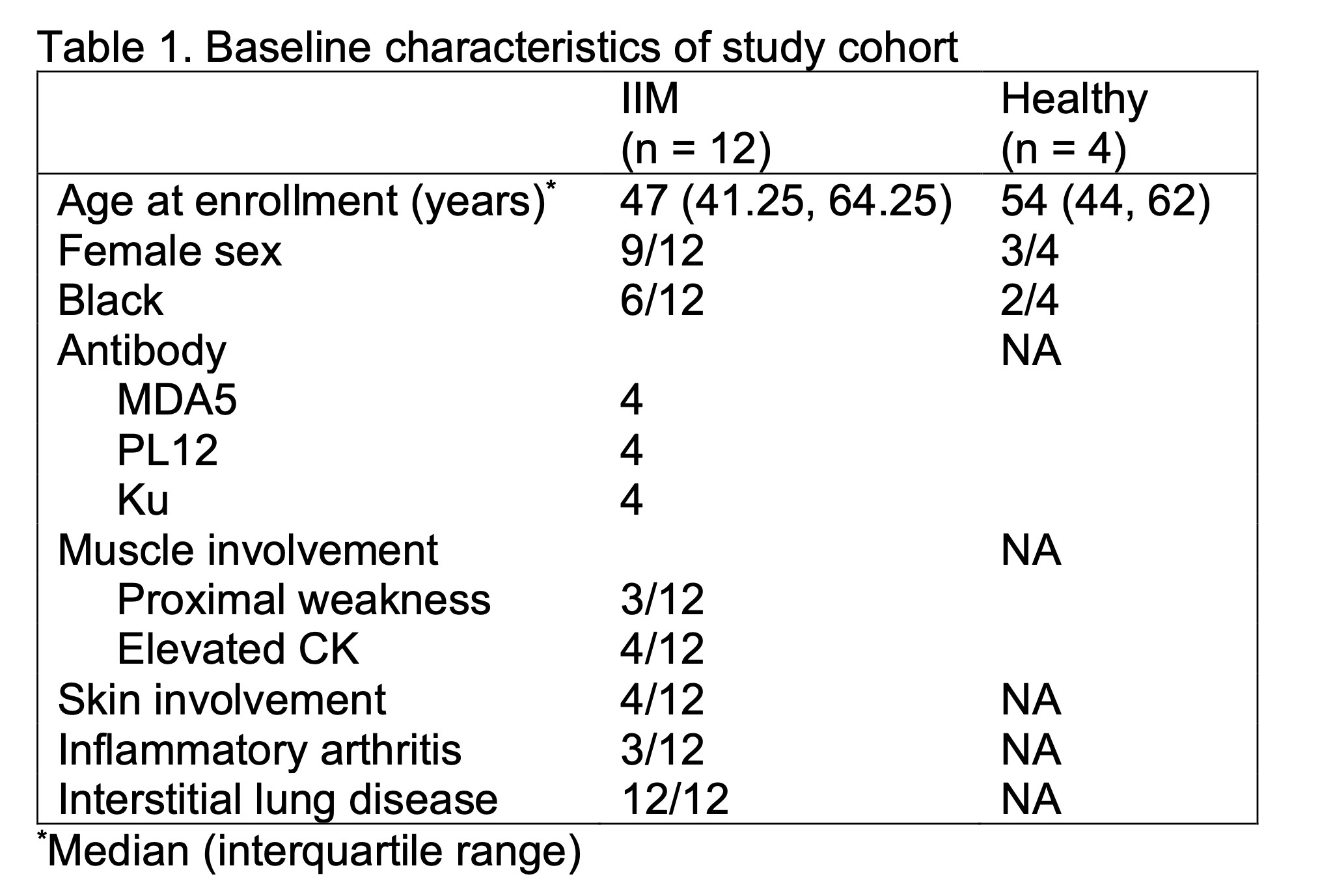Session Information
Date: Saturday, November 16, 2024
Title: Muscle Biology, Myositis & Myopathies – Basic & Clinical Science Poster I
Session Type: Poster Session A
Session Time: 10:30AM-12:30PM
Background/Purpose: Idiopathic inflammatory myopathies (IIM) are a collection of rare, systemic rheumatic diseases. A role for B cells in IIM is indicated by the success of B cell-targeted therapies, like rituximab, belimumab and CD19 CAR-T cell therapy, in some patients. Although diagnosis and prognosis of IIM is guided by the presence of distinct autoantibodies, less is known about how autoreactive B cells breach immune tolerance to produce these autoantibodies. To address this knowledge gap, we compared B cell receptor (BCR) and phenotypic attributes of total and clonally expanded B cells between IIM patients and healthy controls (HC).
Methods: We isolated CD19+ B cells from n=12 IIM patients (with autoantibodies against MDA5, PL12 or Ku; all were rituximab therapy-naive) and n=4 age/sex-matched HC and performed tandem single cell RNA-sequencing and BCR-sequencing. We processed data with CellRanger and used IMGT/HighV-QUEST to analyze B cell repertoire data, including percent variable heavy chain somatic hypermutation (% VH SHM), which was integrated into a custom Seurat v5.0.0-based analysis pipeline. Chi-squared and Mann-Whitney U tests were used in statistical analysis.
Results: Seurat identified 11 distinct transcriptional clusters, which we manually collapsed down to five major B cell subsets (transitional, naïve, activated, memory, and plasmablast) (Fig. 1A-B). B cells with three or more cells per clonotype were identified as clonally expanded (Fig. 1C). B cell subset distribution was significantly altered between IIM and HC in the total (p < 0.001) and clonally expanded B cell populations (p < 0.001) (Fig. 1D-E). Within clonally expanded B cells, 52% of IIM B cells were class switched (30% to IgG and 22% to IgA) compared to HC, in which only 26% of clonally expanded B cells underwent class switching (p < 0.001, Fig. 1F). VH gene usage in clonally expanded B cells was polyclonal; IgGV3-23 was the most frequent V gene used (11%). IIM individuals showed significantly lower % VH SHM within each B cell subset compared to HC (p < 0.001 for all subsets except activated which had p < 0.01) (Fig. 2A). % VH SHM also significanlly differed between clonally expanded and non-clonally expanded cells in IIM (p < 0.001) and HC (p < 0.001) (Fig. 2B). % VH SHM did not significantly differ between expanded HC and IIM B cell clones (p = 0.3).
Conclusion: Total B cells in IIM patients showed B cell subset skewing and reduced % VH SHM within each of these subsets. Clonally expanded B cells in IIM patients showed increased BCR class-switching, but exhibited decreased BCR SHM compared to clonally expanded B cells in HC. These findings are consistent with extrafollicular, rather than germinal center origins, which will require confirmation in future studies focused on B cell responses in disease-related tissues as findings in peripheral blood B cells do not fully reflect all aspects of B cells in tissue.
To cite this abstract in AMA style:
Sawyers A, Crofford L, Wilfong E, Bonami R. Clonally Expanded and Total B Cells in Patients with Idiopathic Inflammatory Myopathies Show Skewed B Cell Subset Distribution and Reduced Somatic Hypermutation Relative to Healthy Controls [abstract]. Arthritis Rheumatol. 2024; 76 (suppl 9). https://acrabstracts.org/abstract/clonally-expanded-and-total-b-cells-in-patients-with-idiopathic-inflammatory-myopathies-show-skewed-b-cell-subset-distribution-and-reduced-somatic-hypermutation-relative-to-healthy-controls/. Accessed .« Back to ACR Convergence 2024
ACR Meeting Abstracts - https://acrabstracts.org/abstract/clonally-expanded-and-total-b-cells-in-patients-with-idiopathic-inflammatory-myopathies-show-skewed-b-cell-subset-distribution-and-reduced-somatic-hypermutation-relative-to-healthy-controls/



